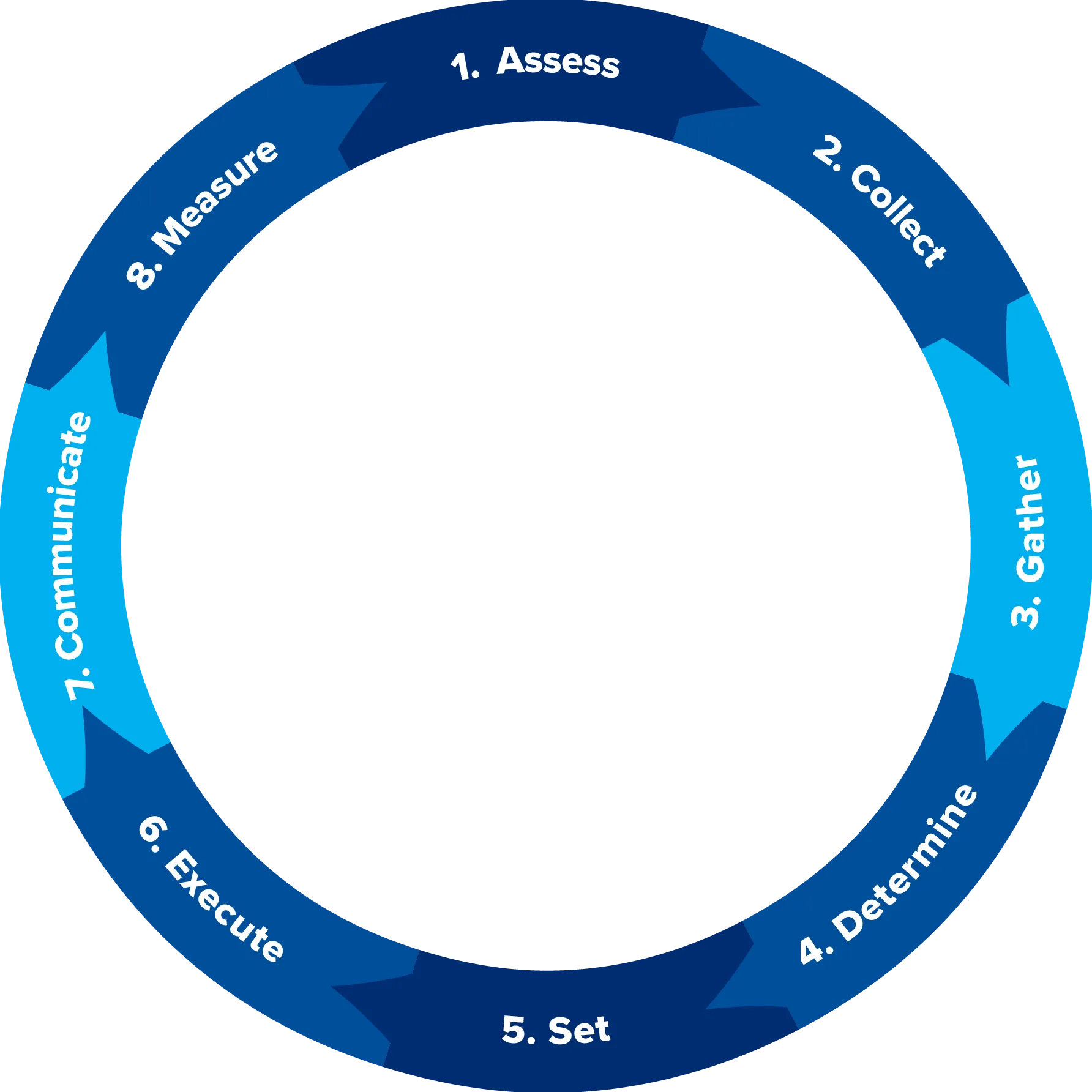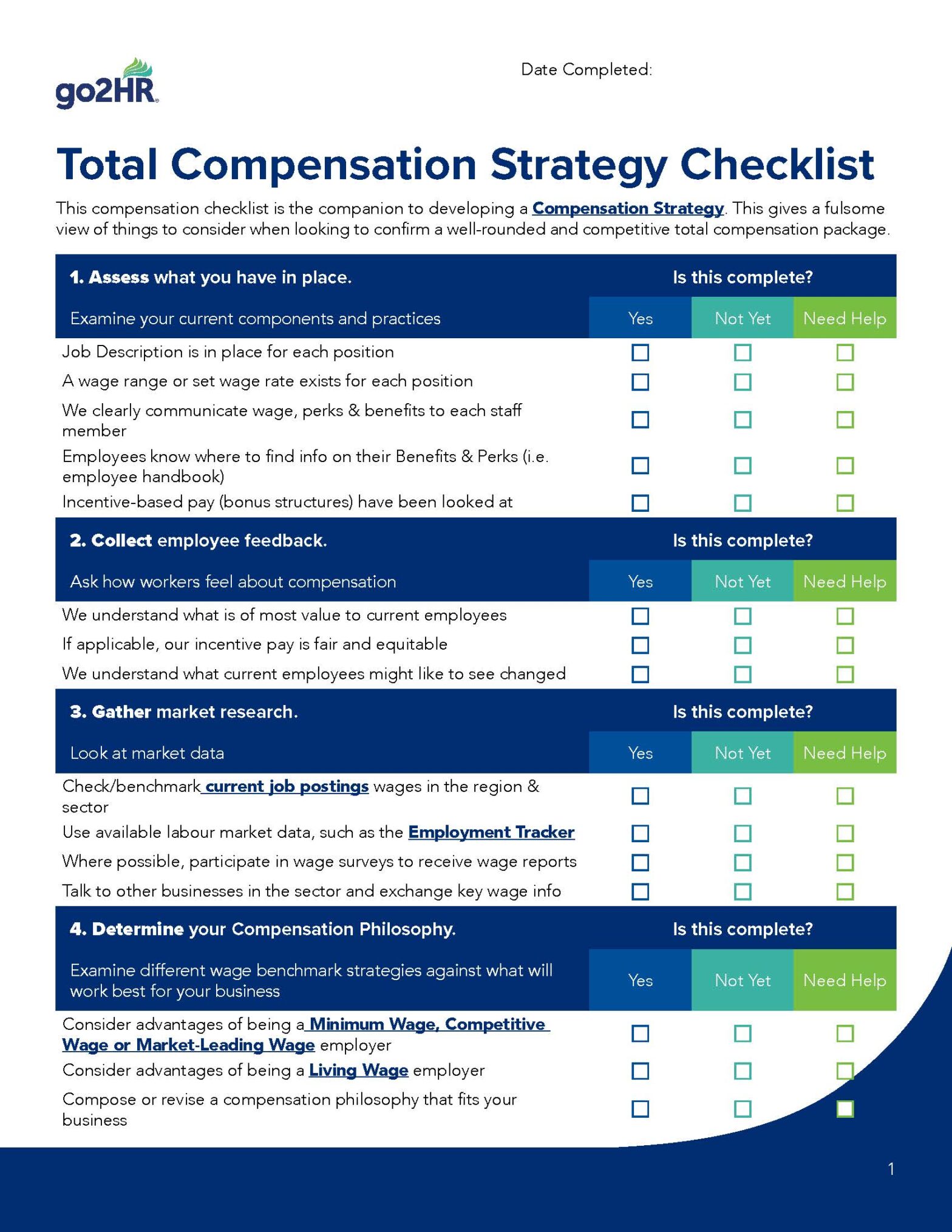February 15, 2024
Industry leaders have their Total Compensation strategy locked in and are using it as a competitive advantage. If you are ready to develop a Total Compensation Strategy, here is what it can look like:
- Assess what you have in place
- Collect employee feedback
- Gather market research
- Determine Compensation Philosophy
- Set your Compensation Rates
- Execute your compensation strategy
- Communicate to employees and candidates
- Measure the impacts and costs

1. Assess what you have in place.
Take a look at what you can offer your staff.
- How many different positions do you have with different pay bands/groups? Updated job descriptions are very helpful for this.
- What is the wage range for each position?
- What benefits and perks do you offer?
- What incentive-based pay do you offer?
2. Collect employee feedback.
Talk to your staff about their total compensation.
- Are they satisfied with their current compensation?
- Do they know about all the benefits and perks that you offer?
- Do their perceived value from your benefits/perks equal what they are costing you?
- What would they like to see added?
Through this process, listen closely to your employees and consider their intrinsic needs and motivations. Sometimes you can identify and offer non-financial incentives like self-directed career growth, workplace autonomy or flexibility that allow you to reward your staff without stretching your budget.
3. Gather market research.
It’s important to understand your local job market. Knowing what wages, benefits and perks are being paid by your direct and indirect competition will help you accurately position yourself in the marketplace.
You can get this data from:
- Job advertisements
- Market data, such as go2HR’s Employment Tracker
4. Determine your compensation philosophy.
Determining your Compensation Philosophy is much more than a simple philosophy and is a decision unique to your business, reflecting who you are and who you want to become. It also needs to reflect the realities of your business, since not every philosophy works for every situation.
Do you want to be a minimum-wage employer? That might be a good business decision if workers are available, staff quality has a limited impact on customer satisfaction and a simple, well-documented training system exists for new hires.
Do you want to be a Living Wage employer or a Market Leading employer? This might be a good business decision if staff quality has a high impact on customer satisfaction, long-term relationships between staff and customers benefit your bottom line and your onboarding and training for new hires is long and arduous.
There are positives and negatives to each approach, and each of them is covered in more depth here.
Compensation Philosophy is often summarized in a Compensation Philosophy Statement, which is shared inside and outside of the company. Here are some examples of what this could look like:
Minimum Wage Philosophy Statement:
We believe in giving people opportunities to enter our industry, gain new skills and grow their careers while keeping our prices low to be competitive in the marketplace.
Competitive Wage Philosophy Statement:
We are committed to paying competitive wages that allow our employees to grow their careers with us. This provides stability to our operations, our team members and our customers.
Market Leading Philosophy Statement:
We want to attract the best talent available in the marketplace to provide market leading customer service and to surround our dedicated staff with the highest quality coworkers available.
Living Wage Philosophy Statement:
We are committed to our community, our customers and our employees. By paying a living wage, we recognize the impacts of poverty in our community and want to be leaders in raising the bar for everyone.
5. Set your Compensation Rates.
How will you determine when to give raises to your employees and what range of increases is appropriate?
Annual performance reviews with a spot raise based on individual and company performance is a common approach. This requires consistency in performing annual reviews for all your staff and assumes that an annual pay review is sufficient.
How do you balance base wages, incentive pay and bonuses?
Would your business benefit from using incentive pay and bonuses to drive your employee behavior, so should you have the strongest base salary your budget can afford? Consider your options in this area and if incentive/bonus pay makes sense for your business.
How do you differentiate the pay between your top, mid and lower performers?
Make sure you have a structure that can properly compensate for different levels of experience and performance within a position.
6. Execute your Total Compensation strategy.
After determining how you want to position yourself in the market, how you want to structure your wage and your wage increases, you are ready to set your compensation.
Be sure to consider the following when setting your wages:
- Consider internal and external equity. Make sure you are consistent in your internal equity and aware of where your compensation stands relative to external equity.
- Ensure your incentive pay and perks are driving the desired behaviors with your Total Compensation. Incentive pay can sometimes drive unintended behaviors which do not benefit your business.
- Consider balance, fairness and inclusiveness of all staff and make sure any changes align with your values, culture and long-term goals.
- BC’s Pay Transparency Act is intended to remove systemic discrimination that continually underpays specific groups of workers. Be aware of this and make sure you are not contributing to the systemic wage discrimination that already exists in the job market.
7. Communicate to employees and candidates.
Now that you have done the work to set up your Total Compensation Strategy, it is time to communicate that to current and prospective employees.
Here are 3 ways to do that:
- Change your pay stubs into Total Compensation statements. This will explicitly show your employees what they are receiving beyond their basic wages/salary.
- Include your Total Compensation in your job advertisements.
- Have a Compensation Philosophy Statement and include it in your employee handbook, on your website and in your place of business.
8. Measure the impacts and costs
“You cannot manage what you cannot measure” Peter Drucker.
You can measure the impact of your Total Compensation Strategy in two distinct ways:
By Statistical Measurement and Analysis:
Measuring changes over time to your:
- turnover rate
- staff vacancies as a percentage of your total staff
- time-to-hire metric
Having a competitive Total Compensation plan should have a positive effect on these three metrics.
It is important to note that these metrics are not always directly linked to satisfaction with Total Compensation and should be considered potential indicators, but not absolute measures. A manager with bad staff relationships can drive turnover and staff vacancies, while an inefficient recruitment process can drag out your vacancies and time-to-hire metrics.
By Talking to Your Workers:
- Conduct employee surveys that dive into Total Compensation, either seasonally, annually or ad hoc
- Talk to your staff, either in a formal meeting or informal setting
- Conduct exit interviews to learn about satisfaction with Total Compensation
The quickest way to learn what your employees are thinking is simply by asking them. go2HR is also here to help. As always, please reach out to your HR Advisor if you require support or have questions
Return to top

